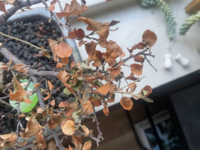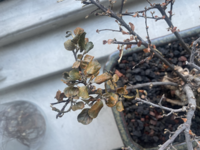mtjzm
Seed
Hello,
I gave my partner a cotoneaster horizontalis, from a bonsai nursery, for her birthday in early April. About a month later, some leaves started turning yellow. She thought she didn't water correctly, but that now turned out was not the source of the problem. Unfortunately, we went on vacation. When we came back yesterday we found the tree without any green leaves and with many tiny, white "sticks" on it. (See the photos.) It is probably some kind of mite? I treated the bonsai with spider mite spray yesterday. However, when I looked at the plant again today, I saw a somewhat bigger—yet still tiny (about 1/8 inch)—white insect crawling around as well. So maybe these tine white "sticks" are larvae?
I have little hope that the bonsai could become healthy again, but maybe there is a tiny chance for it? Any help would be very much appreciated.
I gave my partner a cotoneaster horizontalis, from a bonsai nursery, for her birthday in early April. About a month later, some leaves started turning yellow. She thought she didn't water correctly, but that now turned out was not the source of the problem. Unfortunately, we went on vacation. When we came back yesterday we found the tree without any green leaves and with many tiny, white "sticks" on it. (See the photos.) It is probably some kind of mite? I treated the bonsai with spider mite spray yesterday. However, when I looked at the plant again today, I saw a somewhat bigger—yet still tiny (about 1/8 inch)—white insect crawling around as well. So maybe these tine white "sticks" are larvae?
I have little hope that the bonsai could become healthy again, but maybe there is a tiny chance for it? Any help would be very much appreciated.



